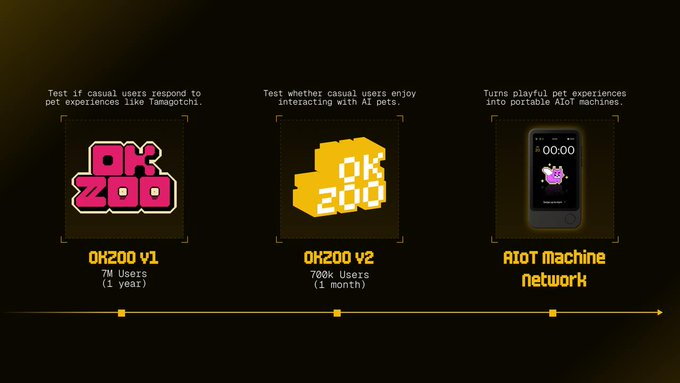OKZOO (AIOT) TGE Event: An Experiment in the Data Economy
On April 25, 2025, Binance Wallet and decentralized exchange PancakeSwap jointly launched the 12th Token Generation Event (TGE), introducing the native token $AIOT of the AIoT project OKZOO. Participation required users to hold at least 45 Binance Alpha Points. Within just two hours, the event was oversubscribed by 500 times, raising over $50 million and setting a new record for Binance Wallet TGE history. This event not only reflects the market’s attention to the AIoT (Artificial Intelligence of Things) sector but also highlights the potential for blockchain technology to integrate with the real-world data economy.

OKZOO’s core concept is to deploy P-mini hardware devices to collect environmental data (such as air quality, noise, and CO2 levels), rewarding users with $AIOT tokens for their contributions. Its innovation lies in the introduction of an “AI pet companion” mechanism, where users optimize environmental parameters to enhance pet status, creating a gamified data collection model. As of April 2025, the OKZOO ecosystem had accumulated 12 million users across 30 countries, becoming a representative project in the DePIN (Decentralized Physical Infrastructure Network) sector.
Technical Architecture and Token Economic Model
OKZOO’s underlying technology combines IoT, AI algorithms, and blockchain:
- Hardware Layer: P-mini devices equipped with various sensors collect data, process it through edge computing nodes, and upload it to on-chain verification nodes.
- Incentive Layer: Users contributing valid data are rewarded with $AIOT, while data validators must stake tokens to participate in consensus, ensuring network decentralization.
- Application Layer: $AIOT tokens are used for governance voting, API calls (such as corporate purchases of environmental datasets), and staking mining, with future plans to link to the carbon credit market.
This TGE released 20 million $AIOT (2% of the total supply), with no lock-up period, at a token price of $0.005 (settled in BNB). Short-term high volatility risks are significant—500x oversubscription implies a large influx of short-term arbitrage funds, leading to potential selling pressure post-launch. For ordinary investors, JuCoin’s spot grid trading tool can help automate buy-low, sell-high strategies within set ranges to reduce manual trading risks.
Market Impact: A New Paradigm in the DePIN Sector
The OKZOO TGE has brought three major impacts to the industry:
User Participation Threshold Innovation
Binance Alpha Points were used for the first time as TGE participation criteria, screening high-net-worth and high-frequency trading users, and promoting asset retention within the Binance ecosystem. The points system, based on asset holdings and trading activity, may become a core user segmentation tool for Web3 projects in the future.
Hardware and On-Chain Collaborative Verification
Traditional DePIN projects (such as Helium) rely on single-function hardware, while OKZOO boosts user stickiness through gamification, achieving a daily device usage time of 47 minutes, far exceeding the industry average of 12 minutes.
Exploration of Data Assetization
The commercial value of environmental data has long been underestimated. OKZOO’s attempt to tokenize such data could open up a market worth hundreds of billions if it connects with regulatory-approved carbon credit systems.
However, potential risks should not be overlooked: 11% of team-reserved tokens will unlock at the end of 2025, potentially exerting selling pressure on the secondary market. Additionally, the accuracy of environmental data and device distribution density are critical. If early nodes concentrate in a few regions, the credibility of on-chain data may be questioned.
Investment Strategies and Risk Management
For investors with different risk preferences, differentiated strategies are recommended:
- Short-term Traders: Focus on price volatility during the initial $AIOT listing; consider phased profit-taking if it exceeds $0.015 (3x the issue price) or stop-loss if it drops below $0.003 (60% of the issue price).
- Long-term Holders: Track the deployment progress of OKZOO devices. If the mass production target of 1 million P-mini o2 devices is achieved by Q3 2025, the on-chain data volume will support token value.
- Ecosystem Participants: Stake $AIOT to become a validator node, with expected annual yields of 8%-15%, while bearing hardware maintenance costs and token volatility risks.
Future Outlook: Compliance and Expansion of the Data Economy
The success of OKZOO will hinge on three factors:
- Regulatory Adaptation: Environmental data involves public governance and must comply with national privacy laws and carbon trading policies. The team plans to apply for Singapore IMDA certification to enhance compliance.
- Cross-Chain Interoperability: Integration progress with the Stargate protocol affects multi-chain data verification efficiency. Delays could hinder ecosystem expansion.
- Token Deflation Mechanism: The current token burn rate is only 0.05%. Raising it above 0.3% would significantly improve the supply-demand structure.
For ordinary users, participating in such innovative projects requires balancing returns and risks. By combining dollar-cost averaging, stop-loss and take-profit tools, and JuCoin’s multi-chain wallet asset management, users can explore frontier sectors while controlling potential losses.




